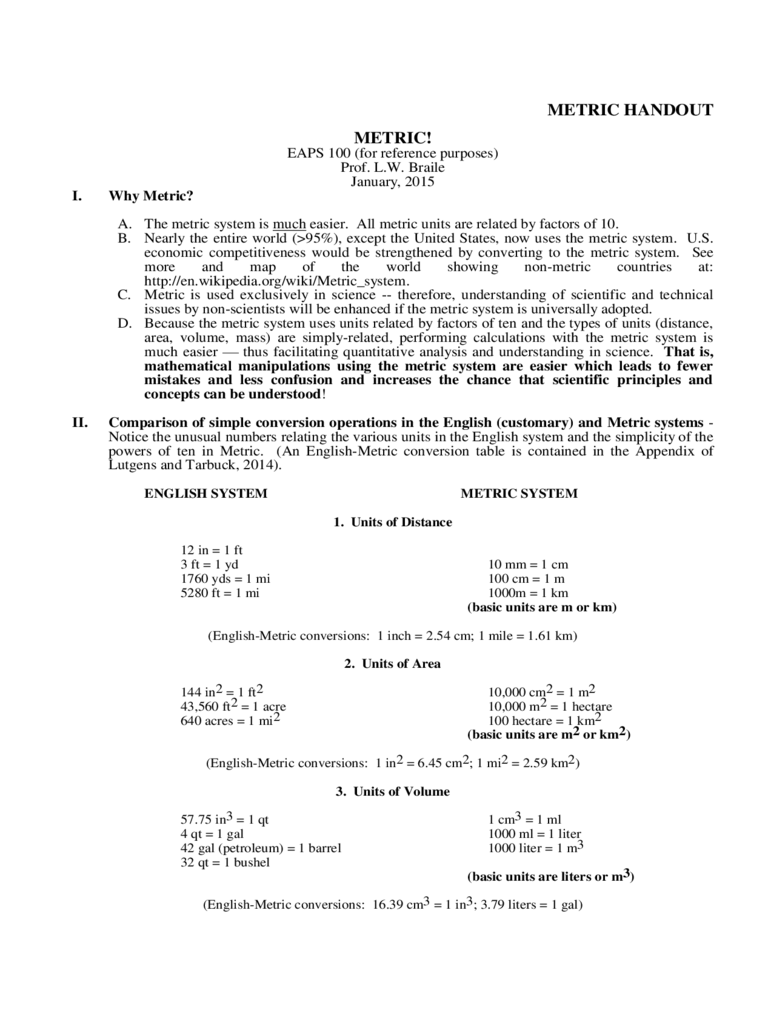Fillable Printable Metric English Conversion Table
Fillable Printable Metric English Conversion Table

Metric English Conversion Table

METRIC HANDOUT
METRIC!
EAPS 100 (for reference purposes)
Prof. L.W. Braile
January, 2015
I. Why Metric?
A. The metric system is much easier. All metric units are related by factors of 10.
B. Nearly the entire world (>95%), except the United States, now uses the metric system. U.S.
economic competitiveness would be strengthened by converting to the metric system. See
more and map of the world showing non-metric countries at:
http://en.wikipedia.org/wiki/Metric_system.
C. Metric is used exclusively in science -- therefore, understanding of scientific and technical
issues by non-scientists will be enhanced if the metric system is universally adopted.
D. Because the metric system uses units related by factors of ten and the types of units (distance,
area, volume, mass) are simply-related, performing calculations with the metric system is
much easier thus facilitating quantitative analysis and understanding in science. That is,
mathematical manipulations using the metric system are easier which leads to fewer
mistakes and less confusion and increases the chance that scientific principles and
concepts can be understood!
II. Comparison of simple conversion operations in the English (customary) and Metric systems -
Notice the unusual numbers relating the various units in the English system and the simplicity of the
powers of ten in Metric. (An English-Metric conversion table is contained in the Appendix of
Lutgens and Tarbuck, 2014).
ENGLISH SYSTEM METRIC SYSTEM
1. Units of Distance
12 in = 1 ft
3 ft = 1 yd 10 mm = 1 cm
1760 yds = 1 mi 100 cm = 1 m
5280 ft = 1 mi 1000m = 1 km
(basic units are m or km)
(English-Metric conversions: 1 inch = 2.54 cm; 1 mile = 1.61 km)
2. Units of Area
144 in
2
= 1 ft
2
10,000 cm
2
= 1 m
2
43,560 ft
2
= 1 acre 10,000 m
2
= 1 hectare
640 acres = 1 mi
2
100 hectare = 1 km
2
(basic units are m
2
or km
2
)
(English-Metric conversions: 1 in
2
= 6.45 cm
2
; 1 mi
2
= 2.59 km
2
)
3. Units of Volume
57.75 in
3
= 1 qt 1 cm
3
= 1 ml
4 qt = 1 gal 1000 ml = 1 liter
42 gal (petroleum) = 1 barrel 1000 liter = 1 m
3
32 qt = 1 bushel
(basic units are liters or m
3
)
(English-Metric conversions: 16.39 cm
3
= 1 in
3
; 3.79 liters = 1 gal)

2
4. Units of Mass
437.5 grains = 1 oz 1000 mg = 1 g
16 oz = 1 lb 1000 g = 1 kg
2000 lb = 1 short ton 1000 kg = 1 metric ton
(basic units are g or kg)
(English-Metric conversions: 453 g = 1 lb; 2.2 lb = 1 kg)
(Mass-volume conversions for water, or material of equal density, are also easy because 1 kg of water = 1 liter =
1/1000 m
3
and 1 g of water = 1 cm
3
)
5. Units of Temperature
Fahrenheit-Celsius-Kelvin conversions:
T(C) = [T(F) - 32] x 5/9
T(F) = T(C) x 9/5 + 32
T(K) = T(C) + 273
(basic units are Kelvin or degrees Celsius/Centigrade)
Convenient Equivalences to Help in Remembering Celsius Scale
T(F) T(C) Conditions
-459 -273 Zero Kelvin (absolute zero)
-40 -40 extremely cold
0 -17
32 0 water freezes
68 20 room temperature
82 28 warm day
98.6 37 body temperature
104 40 hot day
212 100 water boils
Extensive reference information on units of measurements and conversion factors are contained in the following
references:
Jerrard, H.G., and D.B. McNeill, A Dictionary of Scientific Units: Including Dimensionless Numbers and Scales,
6th ed., Chapman and Hall, New York, 255 p., 1992.
Pennycuick, C.J., Conversion Factors, Univ. of Chicago Press, 47 p., 1988.
Weast, R.C. (ed.), Handbook of Chemistry and Physics, CRC Press, Cleveland, OH, 1974.
Web sites: http://en.wikipedia.org/wiki/Metric_system
http://lamar.colostate.edu/~hillger/ www.metric.org
http://www.metric-conversions.org/conversion-calculators.htm
http://www.sciencemadesimple.com/conversions.html

3

4



